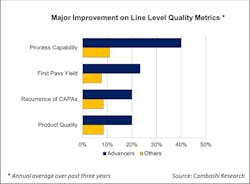Relatively little commodity manufacturing remains in the U.S. or the more developed economies of the world. Which means that most of you reading this are likely involved in complex manufacturing. That complexity could be representative of your manufacturing process, your product, your supply chain or the regulatory environment surrounding your product or production process.
Given that type of environment in which you likely operate, the question becomes: What does it take to be a leader in your industry? With so many varied types of manufacturing, end products, markets and regulations involved, the answer is not an easy one. But research conducted this year by Cambashi (an industry research group) and Apriso (a manufacturing software provider) may well have identified a core element that cuts across the varied types of complex manufacturing environments.
In its research of more than 120 medical device manufacturers, Cambashi sought to address the common challenges faced when medical device manufacturers seek to expand market share, quality and financial performance in the face of complex and dynamic regulatory environments. The results of the study showed that the industry leaders or “advancers” (the top 25 percent of companies) are able to increase product complexity, volume, quality and profits – all at the same time.
According to Cambashi, the key differentiator that gives the “advancers” the ability to perform at this level is their process capability. In essence, the “advancers” define and execute production processes with “superb precision”. To help clarify what this means, consider this: When examining a root cause analysis to determine why an out-of-conformance quality event occurred, the “advancers” focus more effort on improving the process rather than trying to ascertain if the right processes were not executed properly.
This approach favored by industry leaders may seem counter-intuitive. After all, if you’ve got what seems to be a good process in place and something out-of-conformance occurs, the natural tendency is to figure out who or what screwed up your effective process. But with software not only tracking our process-related actions, it also, more often than not, is directing it as well. Thus, if the production software system isn’t screaming an alarm in real-time that a specific step in the process was not followed, odds are that the problem is with the process itself rather than an operator error.
Taking this extra step and asking “why?” is central to the continued, successful execution of a process.
Other findings of Cambashi’s research include:
• A majority of the respondents anticipate launching at least 10 percent more new product introductions over the next three years; 24 percent of the respondents anticipate an increase of greater than 20 percent.
• Industry leaders’ reliance upon IT systems interoperability is directly related to their success; better process integration across functions and plants leads to greater agility, quality, efficiency and profits.
• While Quality by Design is a great start, the benefits can’t be fully realized unless design is accompanied by a quality process that reaches across production on an end-to-end basis, as well across IT systems, company locations and functions.
Leaders relevant to this article:


